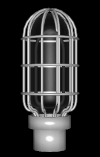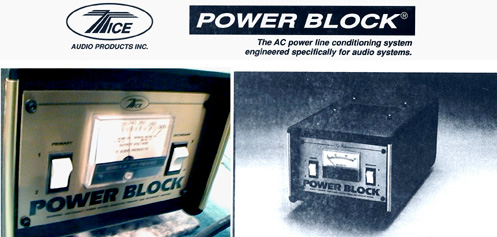 |
|
|
|
|
|
|
|
|
|
|
|
|
|
|
|
|
|
|
|
|
|
|
|
|
|
|
|
|
|
|
|
|
|
|
|
|
|
|
 |
|
|
|
 |
|
|
|
|
|
Tice Power Block |
|
|
|
|
|
 |
|
|
|
 |
|
|
|
The AC power line conditioning system engineered specifically for audio systems. |
|
|
|
IMPROVED IMAGING, CLARITY & HARMONIC ACCURACY
TIGHTER, CLEANER AND MORE EFFORTLESS BASS
CLEANER AMPLIFIER CLIPPING
EFFORTLESS FATIGUE-FREE LISTENING |
|
|
|
|
|
|
|
The POWER BLOCK is the end result of three years of research to
(a) determine what parameters related to AC power are important for audio equipment and
(b) how best to maximize a power conditioner design for these parameters. The result which is phase corrected, allows the user to correct for high or low voltage conditions without the negative sonic signature of amplifiers. The POWER BLOCK has been acclaimed by consumers and reviewers alike, as "THE ABSOLUTE BEST POWER CONDITIONING SYSTEM FOR USE WITH AUDIO EQUIPMENT." |
|
|
|
|
|
|
|
The POWER BLOCK will provide as much of a difference as upgrading a pre-amp or power-amp in your audio system! |
|
|
|
 |
|
|
|
|
|
|
|
TICE POWER BLOCK / TITAN |
|
|
|
High-End Current for the Audiophile |
|
|
|
(By Dennis Krishnan - HIGH-END Issue No.5) |
|
|
|
The growth of the computer industry has led many companies to manufacture and produce all kinds of power line conditioning equipment to protect sensitive computers from contaminated power. It is known that contaminated power will affect computers by corrupting data and the proper functioning of its circuits. Likewise the audiophile must choose to protect his power line from possible contamination which will evidently affect his equipment, hence the performance of the equipment. |
|
|
|
In a high resolution audio system, a contaminated power line can add graininess to the quality of music. It can shorten the soundstage depth and affect intra-silence between sounds. The low frequencies will also lack tightness and power, and highs will bear that edginess with loss of air. |
|
|
|
The Tice Power Block and its counterpart, the Titan are power conditioners designed to help protect and alleviate AC line problems that plague most audio systems. |
|
|
|
THE POWER BLOCK |
|
|
|
It is said to be actually designed for audio use only. It is a hefty 60 pounds custom-built power line conditioner/isolation transformer with a rated capacity of 15 amps. It incorporates a unique feed forward and feedback within the transformer design. |
|
|
|
A design which is phased corrected, I.e. the user may correct for high and low voltage conditions that will enable the use of high voltage power amplifiers. The unit has no power on switch suggesting it be operated continually. All audio components may be plugged via the six 15 amp rated AC outlets provided on the rear of the Power Block. The outlets are fused with a 15 amp replaceable dual-element fuse. |
|
|
|
On the front panel is an illuminated AC voltmeter and two numbered two-way rocker switches. These will select the different combinations of primary and secondary transformer windings to suit your system configuration. |
|
|
|
Unlike most isolation transformers and conditioners the Power Block's housing is made of ABS-plastic which is further reinforced with aluminium braces at its joints. The actual transformer is situated in the middle and seated on special rubber feet to minimize vibrations. Twelve gauge wiring is employed throughout the innards with two 3/3 uf polypropylene capacitors to correct for out-of-phase current use. |
|
|
|
THE TITAN |
|
|
|
An integral part of the Power Block, the Titan is also a 60 pound companion unit for use within the system. It is meant to be plugged into the rear of the Power Block and functions together to form a transient AC energy storage and conditioning system. It is similar in design save for all the switches but different in function. In conjunction with the Power Block it will aid with more momentary current delivery power capable up to 20 amperes. |
|
|
|
Sonics |
|
|
|
Frankly, I did expect some changes when both units were installed into my system. However, I never expected severe changes the way it did. |
|
|
|
Firstly the stage on the STEPS (Pat Coil - Sheffield Lab CD-31) began to swell up. On track two, I found the dynamics more apparent as each instrument consistently exhibited more transient energy and less overhand. Musical notes began and ended more decisively and low level information easily heard. |
|
|
|
On Carmina Burana (Telarc CD80056), the conditioners showed greater dynamics in resolving the power of the orchestra. Instruments began to float and filled the listening room considerably with more openness and dimensionality. There was a definite sense of improvement in the bass region where it was cleaner, tighter and well defined. The top-end also had spark with reduced upper-mid brightness, less noise between instruments and a faster transient response. |
|
|
Fully convinced, I put on the Judds, Heartland (RCA 5916-2a) to relax. I have to report further that the imaging and soundstaging was another area of improvement brought about by the Power Block/Titan combination. Together, they achieved greater separation of the two voices, with each singer precisely placed together between the speakers. |
|
|
|
In summary lest I sound braggy, the Power Block/Titan combi provided for a greater dynamic reach, significantly improved the bass rendering it taut and clean, lowering the noise floor of certain recordings and had substantially increased the transparency of my system. |
|
|
After all is said and done, I do not think I could live without them. Granted, both items would probably burnt a hole in my pocket for a 'working stiff' like myself. However, that is where my money would go if I could well afford them. Ironically I know now that I cannot afford to live without them. What should I do? hmmn.... |
|
|
Note: |
|
|
|
Leave the component on all the time for optimum performance everytime. Do not coil their excess cords or you would create a harmful inductor network. Instead let them lie in free space. Space the equipment away from all audio components and cablings for at least 0.5 meters. Do not use amplifiers that require more than 20 amperes AC input when using the combination or 15 amperes when the Power Block is used as a stand alone. |
|
|
|
|
|
|
|
 |
|
|
|
 |
|
|
|
to The Components page. |
|
|
|
|
|
 |
|
|
|
 |
|
|
 |
|
|
|
|
|
since December 31, 1998 |
|
|
|
|
|
|
|
|
|
|
|
 |
|


